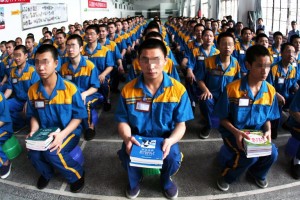Special to WorldTribune.com
By Donald Kirk, East-Asia-Intel.com
President Park Geun-Hye and China’s President Xi Jinping agreed on three core topics when they met last week in Seoul.
North Korea should give up its nukes, China and Korea should vastly expand trade and investment, and Japan’s record in World War II was “barbarous” and “brutal.”

Nowhere in their meetings, however, was there a hint of the way China deals with thousands of its own prisoners in violation of trade rules as well as human rights. There was no mention of China’s sprawling prison network in which inmates spend their days making items for export.
No one said a thing about the beatings inflicted upon prisoners in a system of forced labor that is really a form of modern-day slavery.
Life in Chinese prisons might appear to have little bearing on Chinese-Korean relations, but the story of what goes on there takes on added significance as an issue in international trade. An American teacher, Stuart Foster, who served eight months in a Chinese detention center, describes how prisoners are made to work seven days a week piecing together Christmas tree ornaments for export to the U.S.
“Work was delivered in large industrial bags containing wires, light bulbs and sockets to be assembled,” says Foster. “Inmates would line the wall or sit in circles to complete their work.” Bosses would roam among them to “push production with shouts, slaps, kicks, and if production didn’t increase the inmate would be subjected to a gang beating by the boss’s assistants.” And if that didn’t work “they may be chained to the floor for up to two weeks.”
Foster offered that description of life in a Chinese prison at a briefing that I attended during a recent visit to Washington before returning to Seoul in time for President Xi’s visit. On the table in front of Foster as he spoke was a garland of Christmas tree lights like the ones he put together while held for an offense that he admitted – taking a briefcase containing money from a colleague’s room in China.
Foster was jailed long enough to be able to come up with a fairly precise figure of the total production of his detention center. “I calculated that the Chinese inmates assembled between 6,000 and 8,000 Christmas lights daily,” he says. ”That multiplied by the cells and the average number of persons in each cell,” he goes on, means his center was assembling approximately 2 million lights a day.
In the overall context of China’s enormous foreign trade, products made by prison inmates may not be all that significant. The nature of the complaint may broaden, though, when you consider the conditions under which inmates are working.
Cole Goodrich, a lawyer with the Laogai Research Foundation in Washington, describes life in the Laogai system — Laogai meaning “reform through labor.”
“Every former Laogai system inmate we have interviewed has described performing forced labor and either enduring or witnessing the infliction of brutal torture,” says Goodrich. “This includes physical beatings, raping inmates with electric batons, sticking bodily extremities in ice until the victim develops frostbite, denial of bathroom privileges and other horrific practices.”
Besides producing Christmas lights, he says, “our investigations have uncovered proof of Chinese prisons manufacturing bags, auto parts, handicrafts, jewelry, clothes, chemical products, electronic products such as headphones and cell phone component parts, artificial flowers and other products.”
The Laogai Foundation, which operates a small museum as well as research center in Washington, has uncovered 1,000 detention centers housing anywhere from 2,000 to 50,000 prisoners.
“In addition to the obvious humanitarian concerns, this is a serious trade issue,” says Goodrich. “American manufacturers simply cannot compete with millions of slave laborers working up to 13 hours a day under the constant threat of torture.”
One has to wonder how or whether Korean and other foreign manufacturers can compete any better with such a system. Will the topic come up in negotiations for a Korea-China free trade agreement on which both sides hope to come to terms this year?
China’s exploitation of its own people, of inmates in detention centers, of factory and farm workers toiling at minimal wages, not only violates human rights but gives Chinese industry an edge of which negotiators should be fully aware.
More than likely, however, negotiators will brush over this aspect of Chinese life in the interests of harmony and success on “free trade” — a freedom that ignores the suffering of thousands of prisoners.
People should know what’s going on. It’s easy to beat up on the Japanese for their wartime crimes, ranging from the cruelest biological and medical “experiments” to the exploitation of comfort women, but Xi’s attack on Japan’s record is a distraction from current concerns.
While the Chinese are deepening divisions between Korea and Japan, China’s partners in trade and investment should ask about China’s own record. The “made-in-China” label inside baseball hats and so much else we get from China inspires the questions, who made them, under what conditions?
Columnist Donald Kirk has covered Chinese, Korea, Japanese issues for decades.

You must be logged in to post a comment Login